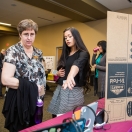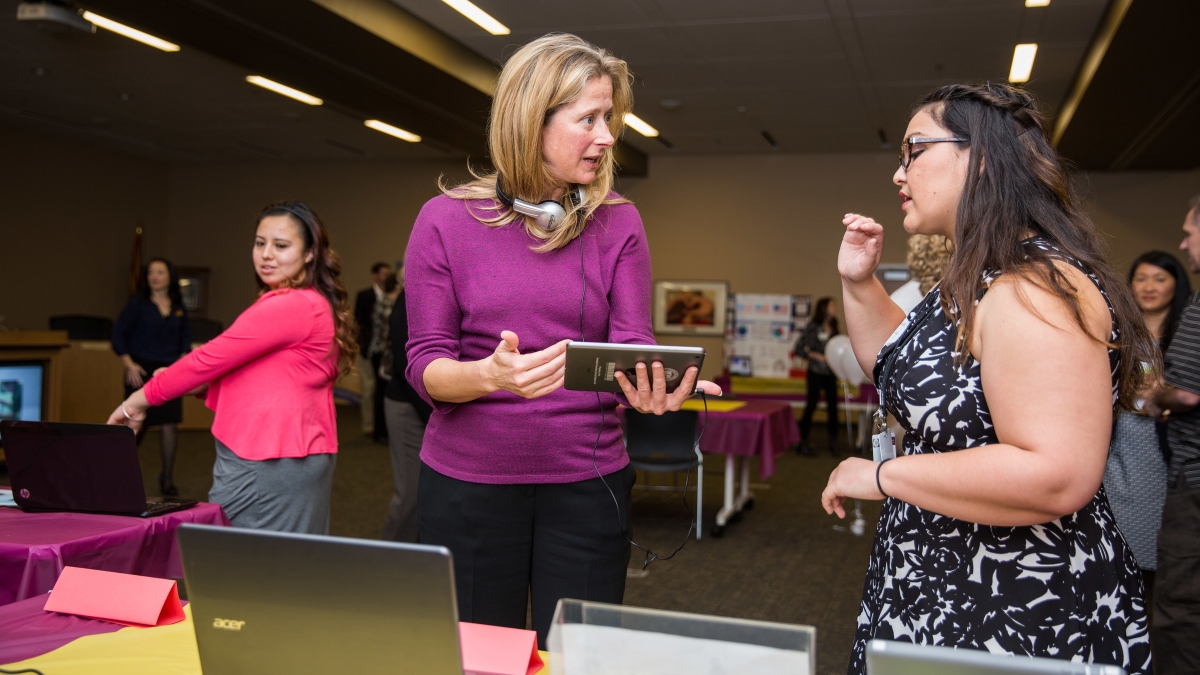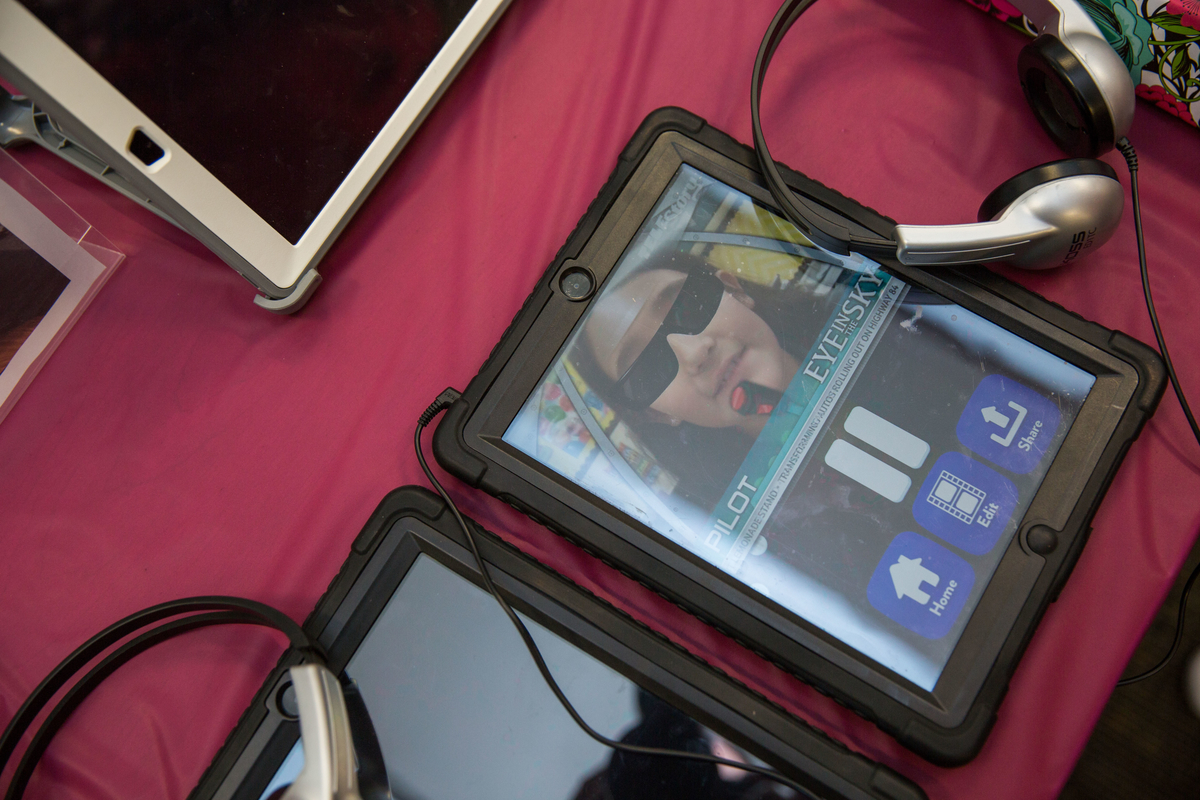A few years ago, students in the Mary Lou Fulton Teachers College took a three-credit course on how to use technology in the classroom.
“There’s something kind of ironic about having a course called ‘integrating technology,’ but it’s a standalone course — it’s not integrated,” said LeeAnn Lindsey, who is in charge of the technology-infusion initiative at the college.
Then that changed. Starting in 2012, the Teachers College dropped the one-time class and began infusing technology into every course that undergraduates take. So when ASU students learn how to teach multiplication tables or American history, they use videos, storytelling applications, animation software and other techniques to improve the lesson.
The goal, Lindsey said, is for the children to be the ones using the technology.
“It’s not just about ‘I’m going to lecture with a PowerPoint behind me.’ It’s how to teach so that students are driving instruction,” Lindsey said.
“The students are the ones creating a website; they’re doing digital videos to show their learning.”
Starting last year — and thanks to a $50,000 donation — some of ASU’s student-teachers took that philosophy into their school classroomsASU partnered with the Avondale, Tolleson and Osborn elementary school districts in metro Phoenix, providing training and iPads for the project. The donation was from the Jane A. Lehman and Alan G. Lehman Foundation., where they saw amazing results. Children learned faster and were more engaged. Lessons were individualized and classrooms became paperless.
All students became enthusiastic, according to Hayley Hoskin Hayley Hoskin (at right in the photo) is in the Mary Lou Fulton Teachers College iTeachAZ yearlong teacher-training program., an ASU student who teaches eighth-grade math in the Avondale Elementary School District.
Hayley Hoskin (at right in the photo) is in the Mary Lou Fulton Teachers College iTeachAZ yearlong teacher-training program., an ASU student who teaches eighth-grade math in the Avondale Elementary School District.
“It was night and day to see that the students who had been disengaged from the lessons — even defiantly not participating — were the ones who created the most abstract and creative presentations,” said Hoskin, whose class created animated stories and wrote a song to explain the concept of proportion.
“It was nice to see how it reached every kind of learner in the classroom.”
A tablet shows a fourth-grade student pretending to be a pilot during the iTeachAZ presentation in Avondale on Jan. 15. Photo by Deanna Dent/ASU Now
'They got it the first time'
ASU students in the iTeachAZ program spend the whole academic year teaching at their schools, not just one semester. They student-teach in a classroom, supervised by experienced mentor teachers, and take their senior-year ASU classes on the school district campus, taught by an ASU faculty member who is the site coordinator.
Lynda Scott is the ASU site coordinator in the Avondale Elementary School District in the West Valley. She jumped at the chance to apply for the technology-infusion program after looking at her data from the previous year. She observed many student-teachers using videos and games, but only once did she see the children using technology. Her goal was to get the technology into the pupils’ hands.
“A lot of people think that classroom management would get worse with technology, but we could see that classroom management was better because the kids were so engaged in what was happening and they were listening,” she said.
Both the student-teachers and their mentors were trained, and Scott modeled how to integrate technology in the ASU classes she taught the pre-service teachers — who needed to see both the good and the bad.
“We knew it would not be perfect,” Scott said. “We knew there would be times when the kids wouldn’t use it appropriately. One day our Internet was out. We had trouble with the apps. But I told them, ‘This is going to happen in the classroom, so what’s your Plan B?’ "
Earlier this month, the student-teachers and their mentors in the Avondale district presented their technology-infusion projects. Among their conclusions:
• Students learn quicker: ASU student-teacher Lola Dominguez teaches first grade and used a storytelling app. “They listened the first time, and they got it the first time.”
• Assessments are faster: Rebecca Haines, who has been teaching for 29 years, tried the Plicker app, in which each student answers on a card with a bar code. She scanned the room and knew immediately how many got the answer right. “It’s a quick and easy assessment, and it helps our understanding of what they understand,” said Haines, a second-grade mentor teacher.
• The students were more engaged: Hoskin said her eighth-graders weren’t required to work on their projects at home, but most did. Being able to create an animated project gave shy students the courage to speak up, she said. “They could just press play and they weren’t standing up there with a poster board.”
• Technology allows more inclusion: ASU student Ashley Kesweder teaches first grade and found the storytelling app perfect for her pre-readers. “They were able to show me what they know without that frustration of not knowing how to spell,” she said.
Partnering with mentors
The various gadgets, apps, programs and methods that teachers use will likely change in the coming years, but the point of the technology infusion is to keep minds open.
“It’s creating a mind-set of embracing any new technology that comes along, with a framework for how to integrate technology that’s not specific to one tool,” Lindsey said.
And that’s important for the experienced teachers as well, said Chris Giles, the K-12 education technology specialist for the Arizona Department of Education.
“This is really sketchy ground for them because they’re not the technology users that the students are,” said Giles, who trains teachers around the state. He sees the ASU program as a key way for the new and experienced teachers to collaborate.
“There’s no age thing, just partnership.”
ASU’s pre-service teachers will continue to use devices, apps, videos and programs as part of their courses, but the $50,000 grant that funded the elementary-school program has expired.
Lindsey said she is searching for more money to offer the program to more schools.
“I would like to find a donor who says ‘This works, I can see it.’ "
Top photo: Betsy Hargrove (center), superintendent of the Avondale Elementary School District, chats with Sara Sanchez, an elementary education senior at ASU, about the project she created with students in her fourth-grade class while working on a Native American unit. Photo by Deanna Dent/ASU Now
More Science and technology

ASU-led space telescope is ready to fly
The Star Planet Activity Research CubeSat, or SPARCS, a small space telescope that will monitor the flares and sunspot activity of low-mass stars, has now passed its pre-shipment review by NASA.…

ASU at the heart of the state's revitalized microelectronics industry
A stronger local economy, more reliable technology, and a future where our computers and devices do the impossible: that’s the transformation ASU is driving through its microelectronics research…

Breakthrough copper alloy achieves unprecedented high-temperature performance
A team of researchers from Arizona State University, the U.S. Army Research Laboratory, Lehigh University and Louisiana State University has developed a groundbreaking high-temperature copper alloy…



